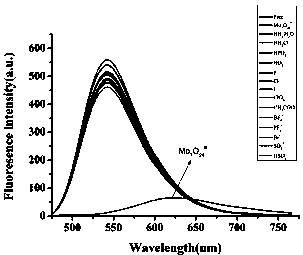Fluorescence probe for recognizing molybdate and production method and recognition method thereof
A technology of molybdate ion and fluorescent probe, which is applied in the direction of fluorescence/phosphorescence, chemical instruments and methods, luminescent materials, etc., can solve problems such as low cost, and achieve the effects of high selectivity, low recognition concentration, and strong anti-interference ability
- Summary
- Abstract
- Description
- Claims
- Application Information
AI Technical Summary
Problems solved by technology
Method used
Image
Examples
Embodiment 1
[0041] Embodiment 1: a kind of preparation method of the fluorescent probe of recognition molybdate ion, the steps are as follows:
[0042] (1) Add 286mg of 1,4-dibromonaphthalene, 263mg of 4-vinylpyridine, 30mg of palladium dichloride, 100mg of triphenylphosphine and 400mg of potassium carbonate into 4ml of triethylamine and mix, and seal the mixture in N 2 In a high-pressure reaction flask under atmosphere, react at 115°C for 30 hours, extract the product 3 times with dichloromethane, then extract 3 times with saturated brine, then dry with anhydrous magnesium sulfate for 1.5 hours and then spin dry. 95% ethanol was recrystallized, and then filtered and dried to obtain product A;
[0043] (2) Product A is dissolved in N,N-dimethylformamide, then 1-bromo-n-octane is added in a ratio of 1:20 according to the amount of product A and 1-bromo-n-octane, heated to 85°C, react for 22 hours, then add diethyl ether until it completely precipitates, filter with suction, wash the preci...
Embodiment 2
[0044] Embodiment 2: a kind of preparation method of the fluorescent probe of recognition molybdate ion, the steps are as follows:
[0045] (1) Add 286mg of 1,4-dibromonaphthalene, 263mg of 4-vinylpyridine, 30mg of palladium dichloride, 100mg of triphenylphosphine and 400mg of potassium carbonate into 3ml of triethylamine and mix, and seal the mixture in N 2In a high-pressure reaction flask under atmosphere, react at 110°C for 24 hours, extract the product 3 times with dichloromethane, and then extract 3 times with saturated brine, then dry it with anhydrous magnesium sulfate for 1 hour and then spin it dry with a concentration of 96 % of ethanol for recrystallization, and then filter and dry to obtain product A;
[0046] (2) Product A is dissolved in N,N-dimethylformamide, then 1-bromo-n-octane is added in a ratio of 1:20 according to the amount of product A and 1-bromo-n-octane, heated to 80°C, react for 20 h, then add diethyl ether until it completely precipitates, filter ...
Embodiment 3
[0047] Embodiment 3: a kind of preparation method of the fluorescent probe of recognition molybdate ion, the steps are as follows:
[0048] (1) Add 286mg of 1,4-dibromonaphthalene, 263mg of 4-vinylpyridine, 30mg of palladium dichloride, 100mg of triphenylphosphine and 400mg of potassium carbonate into 5ml of triethylamine and mix, and seal the mixture in N 2 In a high-pressure reaction flask under atmosphere, react at 120°C for 36 hours, extract the product 3 times with dichloromethane, and then extract 3 times with saturated brine, then dry it with anhydrous magnesium sulfate for 2 hours and spin it dry with a concentration of 96 % of ethanol for recrystallization, and then filter and dry to obtain product A;
[0049] (2) Product A is dissolved in N,N-dimethylformamide, then 1-bromo-n-octane is added in a ratio of 1:20 according to the amount of product A and 1-bromo-n-octane, heated to 90°C, react for 24 hours, then add diethyl ether until it completely precipitates, filter...
PUM
 Login to View More
Login to View More Abstract
Description
Claims
Application Information
 Login to View More
Login to View More - R&D
- Intellectual Property
- Life Sciences
- Materials
- Tech Scout
- Unparalleled Data Quality
- Higher Quality Content
- 60% Fewer Hallucinations
Browse by: Latest US Patents, China's latest patents, Technical Efficacy Thesaurus, Application Domain, Technology Topic, Popular Technical Reports.
© 2025 PatSnap. All rights reserved.Legal|Privacy policy|Modern Slavery Act Transparency Statement|Sitemap|About US| Contact US: help@patsnap.com



